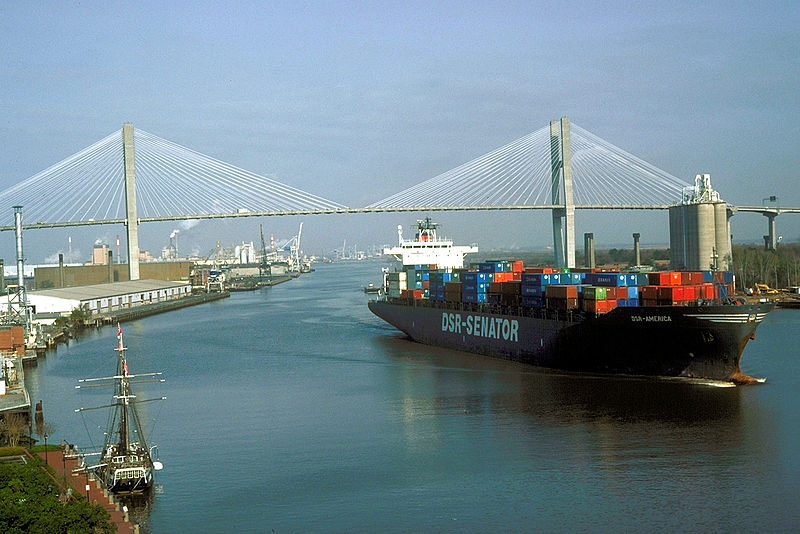
Savannah is the largest city and the county seat of Chatham County, in the U.S. state of Georgia. Established in 1733, the city of Savannah was the colonial capital of the Province of Georgia and later the first state capital of Georgia. Today Savannah is an industrial center and an important Atlantic seaport. It is Georgia's fourth largest city and third largest metropolitan area.
Each year Savannah attracts millions of visitors, who enjoy the city's architecture and historic buildings: the birthplace of Juliette Gordon Low (founder of the Girl Scouts of the United States of America), the Georgia Historical Society (the oldest continually operating historical society in the South), the Telfair Academy of Arts and Sciences (one of the South's first public museums), the First African Baptist Church (one of the oldest African American Baptist congregations in the United States), Temple Mickve Israel (the third oldest synagogue in America), and the Central of Georgia Railway roundhouse complex (the oldest standing antebellum rail facility in America).

Savannah's downtown area, which includes the Savannah Historic District, the Savannah Victorian Historic District and 22 parklike squares, is one of the largest National Historic Landmark Districts in the United States (designated by the U.S. government in 1966). Downtown Savannah largely retains the original town plan prescribed by founder James Oglethorpe (a design now known as The Oglethorpe Plan). Savannah was the host city for the sailing competitions during the 1996 Summer Olympics held in Atlanta.
On February 12, 1733, General James Oglethorpe and his settlers landed at Yamacraw Bluff and were greeted by Tomochichi, the Yamacraws, and Indian traders John and Mary Musgrove. Mary Musgrove often served as a translator. The city of Savannah was founded on that date, along with the colony of Georgia. In 1751 Savannah and the rest of Georgia became a Royal Colony and Savannah was made the colonial capital of Georgia.

The city was named for the Savannah River, which probably derives from variant names for the Shawnee, a Native American people who migrated to the river in the 1680s. The Shawnee destroyed another Native people, the Westo, and occupied their lands at the head of the Savannah River's navigation on the fall line, near present-day Augusta. These Shawnee were known by several local variants, including Shawano, Savano, Savana and Savannah. Another theory is that the name Savannah refers to the extensive marshlands surrounding the river for miles inland, and is derived from the English term savanna, a kind of tropical grassland, which was borrowed by the English from Spanish sabana and used in the Southern Colonies. (The Spanish word comes from the Taino word zabana.)Still other theories suggest that the name Savannah originates from Algonquian terms meaning "southerner" or perhaps "salt".

According to the United States Census Bureau, Savannah has a total area of 78.1 square miles (202.3 km2), of which 74.7 square miles (193.5 km2) is land and 3.4 square miles (8.8 km2) is water (4.31%). Savannah is the primary port on the Savannah River and the largest port in the state of Georgia. It is also located near the U.S. Intracoastal Waterway. Georgia's Ogeechee River flows toward the Atlantic Ocean some 16 miles (26 km) south of the city.
Savannah is prone to flooding. Five canals and several pumping stations have been built to help reduce the effects: Fell Street Canal, Pipemaker's Canal, Kayton Canal, Springfield Canal and the Casey Canal, with the first four draining north into the Savannah River.

Climate
Savannah's climate is classified as humid subtropical (Köppen Cfa). In the Deep South this climate is characterized by long and almost tropical summers, with temperatures reaching freezing only a few times in the winter (and with rare snowfall). Due to its proximity to the Atlantic coast, Savannah rarely experiences temperatures as extreme as those in Georgia's interior. Nevertheless, temperatures as high as 105 °F (41 °C) and as low as 3 °F (−16 °C) have been recorded. Summers tend to be humid with many thunderstorms. Nearly half of Savannah's precipitation falls during the months of June through September, characteristic of monsoon-type climates. As the city is south of the snow line, it rarely receives snow in winter. Occasional Arctic cold fronts in winter can push nighttime temperatures into the high 20s, but rarely much further than that.
Savannah is at risk for hurricanes, particularly of the Cape Verde type. Because of its location in the Georgia Bight (the arc of the Atlantic coastline in Georgia and northern Florida) as well as the tendency for hurricanes to re-curve up the coast, Savannah has a lower risk of hurricanes than some other coastal cities such as Charleston, South Carolina. Savannah was seldom affected by hurricanes during the 20th century, with one exception being Hurricane David in 1979. However, the historical record shows that the city was frequently affected during the second half of the 19th century. The most prominent of these storms was the 1893 Sea Islands hurricane, which killed at least 2,000 people. (This estimate may be low, as deaths among the many impoverished rural African-Americans living on Georgia's barrier islands may not have been reported.)



